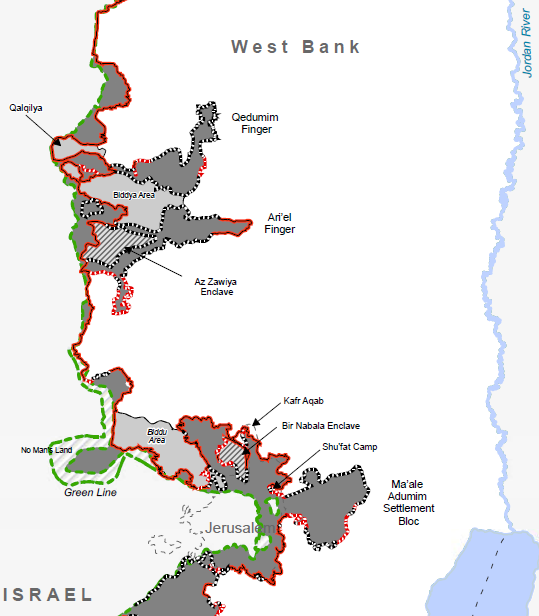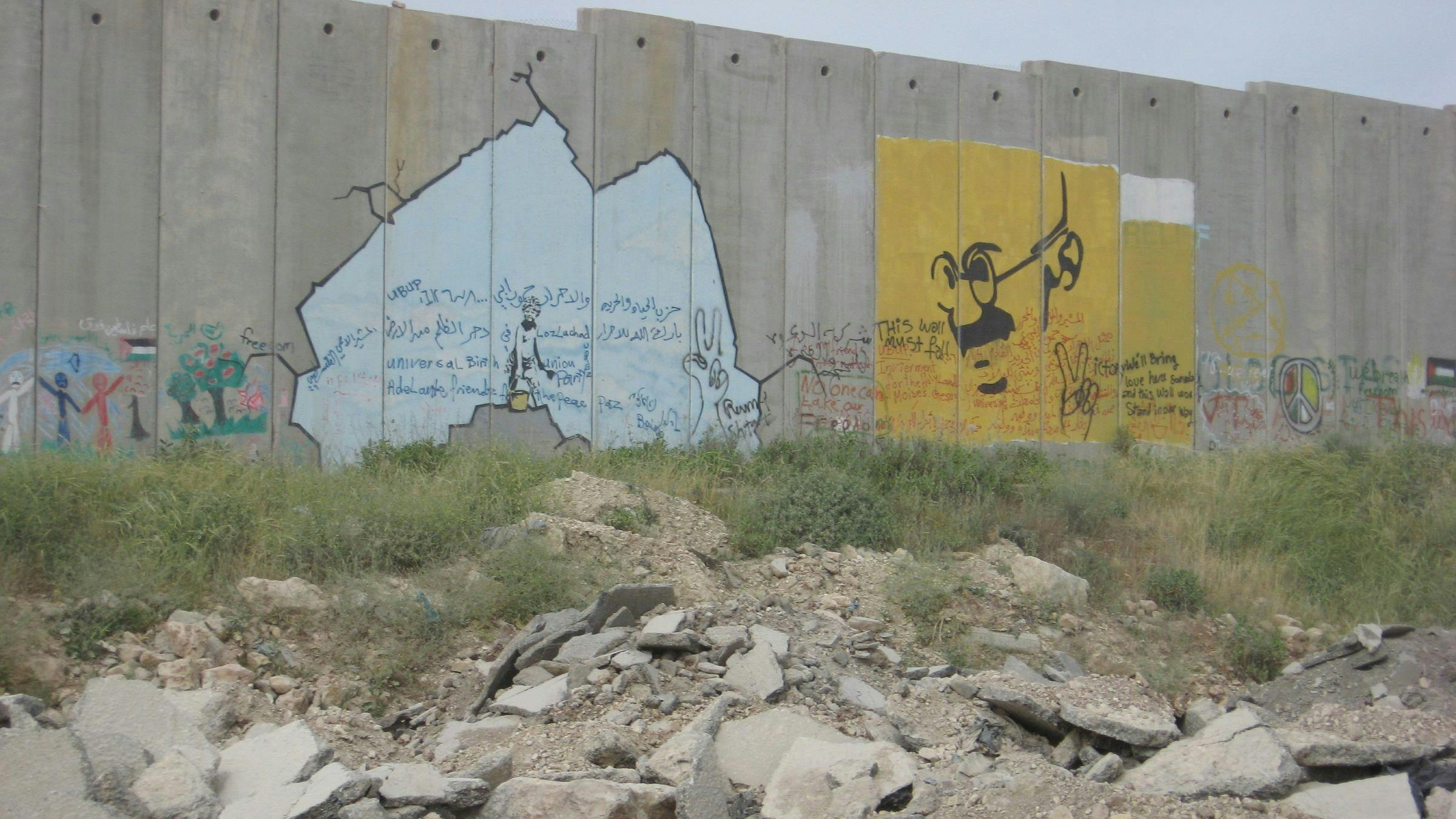Israel cannot rely on a right of self‑defence or on a state of necessity in order to preclude the wrongfulness of the construction of the wall. The Court accordingly finds that the construction of the wall and its associated régime are contrary to international law.
International Court of Justice1
Why is it so that a structure proclaimed illegal (or in breach of international treaties) by the General Assembly, the Red Cross, Amnesty International, Human Rights Watch, and Israeli human rights groups continue construction for nearly a decade?
The “Israeli West Bank Barrier” (also known as the “security fence” by the Israelis, and the “segregation wall” by Arabs), has been in existence since the Oslo Accords in 1993. However, such barrier only transformed to be a threat to the very existence of Palestinians after the al-Aqsa Intifada in 2000.
According to the Israeli story, the logic behind the barrier is obvious: security. The wall is aimed at reducing “Palestinian violence” and protecting citizens of the Israeli states.
That’s all fine and dandy, until we get to one stipulation: the path and structure of the wall is simply irrelevant to security. Instead of having the wall be built on the 1949 Armistice Lines (more commonly known as the Green Line), you will find the wall divergent in multiple areas, continuously annexing land from the Palestinian West Bank, essentially rendering it Israeli de facto.
The wall goes through unbelievable lengths, with its past east of the Israeli settlements (that have also been deemed illegal by the international communities), engulfing them and their surrounding areas as Israeli land and leaving nothing to Palestinians.

To put things into perspective, the wall’s length is 723 km, while the Green Line between the West Bank and Israel is only half the length. Furthermore, only 14% will be built on the Green Line, with the remaining 86% built inside the West Bank.2
The existence of the walls means that thousands of schoolchildren can’t get to school, hundred of thousands surrounded by the wall and can’t travel elsewhere in their own territory without elaborate procedures, and many others with no place to work, no land to grow, and no crops to gather.
Here are some interesting tidbits from the United Nations Office for the Coordination of Humanitarian Affairs’ report on the West Barrier route, published in July 2009 (full document will be listed in further readings section):
- The Bethlehem governorate is 660 km2. Only 13 percent of Bethlehem’s land is available for Palestinian use, much of this fragmented
- The Barrier cuts off West Bank Palestinians and care providers from specialist and tertiary health care in the six specialist hospitals in East Jerusalem.
- The Barrier cuts off Muslims and Christians from religious sites in Jerusalem.
Israeli peace group Peace Now adds (report will also be added to further readings list):
- The fence has created many Palestinian cities (i.e. Kalkiliya), villages and Jerusalem neighborhoods to completely cut off and caged without any freedom of movement.
- The current route of the fence will annex de-facto around 8-10% of the West Bank land
Peace Now continues to add:
the actual fence continues to be constructed deep within Palestinian territory.**The current route of the fence is intended to destroy all chances of a future peace settlement with the Palestinians and to annex as much land as possible from the West Bank.**Thus the method of creating facts on the ground by annexing land to existing settlements continues, this time by using the route of the fence.
The wall is simply not a just solution, and cannot be rationalized by waving the good old “security” banner. Not this time. Institutions internationally have stressed the unlawfulness of this structure over and over again. International leaders have acknowledged that the wall is a problem, both for the existence of a viable Palestinian state, and even further: any sustainable peace effort to begin with. In his time, U.S. President George W. Bush affirmed the illegality of the wall, and today, President Barrack Obama explicitly states that settlements (and their by-products) are a problem that hinders the cause of peace.
What I’m trying to say here is: the world knows its wrong, the have for the past 8 years; the reason no one is doing anything about it, and the reason the Security Council has stood mute for the past 5 years (even after an ICJ ruling), is because no one seems to care just enough to do anything about it. So much for humanity.
To the west of these concrete blocks, life is perfectly fine. News of the Palestinian mother whose unborn child’s first sight is a hostile soldier alertly holding a gun towards its mother and young father are nowhere to be heard. As far as the Israelis know (or would like to believe), school children are not denied education, and lives are not being destroyed. But alas, they are.
What happened to accountability? Israel: you do not only have a responsibility towards your own citizens, but a global responsibility towards humanity, just as every other country in the world does. And that responsibility simply involves allowing others in the human race to live in peace. Just because you are the country of the chosen people doesn’t exempt you from your human duty of honoring human rights of your neighbors.
Moving up the ladder of politics, we get to the current minister of Israel, Benyamin Netanyahu. A man who stood defiant to peace efforts, genuinely supportive of completing the wall, and incredibly encouraging to the process of continued settlement expansion. But I (and any other Arab) welcome any genuine efforts towards peace, regardless of their source. Mr. Netanyahu, if you want to be serious about peace, if you want to show the world a gesture, a real gesture, that you are as committed to cherishing the human rights of your neighbors as you do to your people, then Mr. Netanyahu, tear down this wall.
Further Readings
- UN OCHA West Bank Barrier Report, July 2009
- Peace Now - Positions on the Wall
- Palestine Monitor Wall Factsheet
- Map of the Separation Barrier, as of February 2008
Footnotes
-
Legal Consequences of the Construction of a Wall in the Occupied Palestinian Territory, 9 July 2004, International Court of Justice. ↩ ↩2
-
Palestine Monitor Factsheet - The Wall, Updated 16 December 2008, Palestine Monitor. ↩
